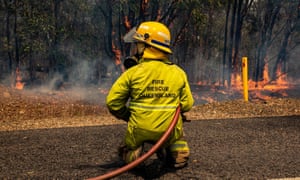State of the climate report points to a long-term increase in the frequency of extreme heat events, fire weather and drought
Australia is experiencing more extreme heat, longer fire seasons,
rising oceans and more marine heatwaves consistent with a changing
climate, according to the Bureau of Meteorology and CSIRO’s state of the
climate report.
The report, published every two years, measures the long-term variability and trends observed in Australia’s climate.
The 2018 report shows that Australia’s long-term warming trend is continuing, with the climate warming by just over 1C since 1910 when records began.
The report, published every two years, measures the long-term variability and trends observed in Australia’s climate.
The 2018 report shows that Australia’s long-term warming trend is continuing, with the climate warming by just over 1C since 1910 when records began.
That warming is contributing to a long-term increase in the frequency of extreme heat events, fire weather and drought.
“Australia is already experiencing climate change now and there are impacts being experienced or felt across many communities and across many sectors,” said Helen Cleugh, the director of the CSIRO’s climate science centre.
- Australia’s fire seasons have lengthened and become more severe. In some parts of the country, the season has been extended by months.
- The number of extreme heat days continues to trend upward.
- There has been a shift to drier conditions in south-eastern and south-western Australia in the months from April to October.
- Rainfall across northern Australia has increased since the 1970s, particularly during the tropical wet season in north-western Australia.
- Oceans around Australia have warmed by about 1C since 1910, which is leading to longer and more frequent marine heatwaves that affect marine life such as corals.
- Sea levels around Australia have risen by more than 20cm since records began and the rate of sea level rise is accelerating.
- There has been a 30% increase in the acidity of Australian oceans since the 1800s and the current rate of change “is ten times faster than at any time in the past 300 million years”.
The report also highlights an increase in the number of extreme fire danger days in many parts of Australia, particularly in southern and eastern Australia.
“Often the worst fire weather occurs when you’ve had long-term drought, long-term above-average temperatures, maybe a short-term heatwave and then the meteorology that’s consistent with severe fire weather and the ability for fire to spread,” he said.
“It’s those types of compound events that are going to be most challenging going forward in terms of adapting to climate change in Australia.”
“The big line around oceans warming one degree since 1910 is a huge wake-up call,” he said.
“It’s undeniable that warming oceans lead to more marine heatwaves, coral bleaching and coral mortality.”
He said the impact of climate change on the Great Barrier Reef, and climate change policy generally, would be a key campaign issue ahead of the 2019 federal election.
“We are running out of time to keep warming to a safe degree for the reef to have a future,” Cazzulino said.

No comments:
Post a Comment